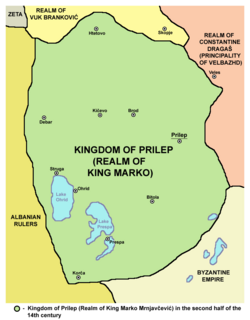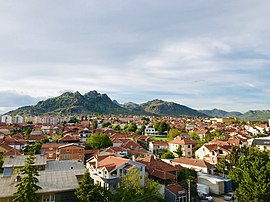Prilep
Prilep
Прилеп (Macedonian) | |
|---|---|
From top, clockwise: panorama of Prilep from Hotel Kristal Palas; Čento Square; Čarši Mosque ruins; Mound of the Unbeaten; Memorial Museum of October 11, 1941; Church of Saints Cyril and Methodius; commercial building in city centre | |
|
UTC+1 (CET) | |
| Postal codes | 7500 |
| Area code | (+389) 048 |
| Patron saints | Saint Nicholas |
| Climate | Cfa |
| Website | www |
Prilep (Macedonian: Прилеп [ˈpriːlɛp] ⓘ) is the fourth-largest city in North Macedonia.[2] According to 2021 census, it had a population of 63,308.
Name

The name of Prilep appeared first as Πρίλαπος in Greek (Prilapos) in 1014, and was mentioned by
In other languages it is:
- Greek: Prilapos, Πρίλαπος
- Albanian: Përlep or Përlepi, or Prilep or Prilepi
- Bulgarian and Serbo-Croatian: Прилеп / Prilep
- Latin: Prilapum
- Aromanian: Pãrleap[4]
- Turkish: Pirlepe, or Perlepe
Economy
Prilep is a centre for high-quality
Tobacco is one of Prilep's traditional cash crops and prospers in the Macedonian climate. Many of the world's largest cigarette makers, such as
A Gentherm production plant is located in Prilep.
Demographics
The overwhelming majority of the city population is Macedonian; the Macedonian population at the last census counted 64,527. There is also a Romani minority, counting some 4,420 inhabitants, most of them living in the neighbourhood of Trizla, also Serbs (310) and Turks (260).
History



In antiquity, the region of Prilep was part of ancient Pelagonia that was inhabited by the
> in 1014, as the place where Bulgarian
During the Ottoman period, besides the ethnic Turks and the majority Slavic population, Prilep was also home to both a Sunni Muslim and Orthodox Christian Albanian community, which lived alongside . Serbian historiographer Jovan Hadži-Vasiljević writes that: '[11]
- "Between Turks and Muslim Albanians who have lived in the city (Prilep), it is very difficult to distinguish, especially between the old families of the city. The Mohammedan Albanian families, as soon as they arrived in the city, merged with the Turks, just as the Christian Albanian families merged with the Slavs or the Greeks"
Bulgarian researcher, Georgi Traichev, wrote that:
- "In the city of Prilep, there were no pure Greeks, but there are several (dozens) of Grecomans supported by schismatic Vlachs and Albanian Christians."[12]
The newspaper Прилепу преди 100 години ("Prilep 100 years ago". Sofia, 1938) puts forward data about the presence of Orthodox Albanians in Prilep. There it is emphasized that after their arrival in the city around the 18th-19th century, the Christian Vlach and Albanian elements have assimilated under the influence of Bulgarian population, and that there are no longer any traces of them. Information is also given for Albanians of both denominations. It is emphasized that in total there are 2412 Muslim Albanian residents in the city. Of the Orthodox Albanians, a part has been
Prilep was a major center of the
In the late 19th and early 20th century, Prilep was part of the
Culture


- One of the most important institutions in the city is the Institute of Old Slavic Culture.
- An art colony is hosted in the center of Prilep in the Center of Contemporary Visual Arts. The colony was founded in 1957 by the archaeologist Prof. Boshko Babikj, but organized by the initiative of Prof. Babikj and the academic painter Prof. Risto Lozanovski, making it perhaps one of the oldest colonies in southeastern Europe and the oldest one on the Balkans, for sure. It hosts painters and sculptors (working in marble, metal and wood) every year and, periodically, it hosts workshops and symposia for vitrage (glass design), mosaics, photography, graphics and clay, from countries around the world. The collection of sculptures carved in wood was acknowledged as a cultural heritage by the most relevant criticizers and opinion makers. 2007 was the 50th anniversary of the colony.
- Every year in October the International Children's Music Festival "Asterisks"brings together children from all over the world.
- Every year the Professional Theatre Festival of Macedonia, honouring .
- The Monastery of Zrze and the Monastery of the Holy Archangel Michael which has 12th and 14th-century frescoes are notable sites of the culture of Prilep.
- Pivofest (Beer fest) is an annual four-day party held in the middle of July that attracts around 200,000 visitors to the city. There are international popular music acts performing nightly on the main stage in the square as well as at the various clubs around town. Pivofest features a growing number of foreign and domestic beers as well as an opportunity for Prilep to showcase its famous barbecue considered the best in North Macedonia.
- Pročka is a centuries-old religious holiday of forgiveness and celebration that in 2001 found an organized manifestation as "Prilep Carnival" and has been a member of the Federation of European Carnival Cities since 2006. Despite the new official name, the festival is still known as Pročka by the locals and is called Pročka in the official tourist guide. The highlight of the festival is the mask parade which runs through the centre of the town and hosts participants from multiple European countries. There is a prize given for the best costume and many of the costumes are elaborate. There are also concerts, parties, and much traditional food during the festival which is held in February.
Language
The dialect of Prilep, forms the basis for the
Art and Architecture



The main square in Prilep is called "Alexandria", in honor of Alexander the Great. The reconstruction of the square began in 2005 and it was completed in 2006. The reconstruction cost 700.000 Euros and its investor was the city of Prilep. During the reconstruction the monument of Alexander the Great was erected, among the other things.[18]
Several ancient sites grace Prilep including one at
The most important ancient monument is the old city of Styberra situated on Bedem hill near Čepigovo, in the central region of Pelagonia. As early as the time of the Roman–Macedonian wars, this city was known as a base from which the Macedonian king
The
Geography
Prilep covers 1,675 km2 (647 sq mi) and is located in the northern
Demographics
As of the 2021 census, Prilep had 63,308 residents with the following ethnic composition:
- Macedonians: 54,028
- Turks: 82
- Persons for whom data are taken from administrative sources: 4,692
- Serbs: 107
- Romani: 3,966
- Albanians: 106
- Vlachs: 30
- Others: 3
Climate
| Climate data for Prilep | |||||||||||||
|---|---|---|---|---|---|---|---|---|---|---|---|---|---|
| Month | Jan | Feb | Mar | Apr | May | Jun | Jul | Aug | Sep | Oct | Nov | Dec | Year |
| Mean daily maximum °C (°F) | 4.8 (40.6) |
9.0 (48.2) |
12.5 (54.5) |
17.6 (63.7) |
22.2 (72.0) |
26.7 (80.1) |
29.9 (85.8) |
30.3 (86.5) |
25.0 (77.0) |
18.8 (65.8) |
13.6 (56.5) |
7.4 (45.3) |
18.2 (64.7) |
| Daily mean °C (°F) | 1.2 (34.2) |
4.4 (39.9) |
7.3 (45.1) |
12.0 (53.6) |
16.1 (61.0) |
20.4 (68.7) |
23.0 (73.4) |
23.2 (73.8) |
18.7 (65.7) |
13.1 (55.6) |
8.9 (48.0) |
3.5 (38.3) |
12.7 (54.8) |
| Mean daily minimum °C (°F) | −2.5 (27.5) |
−0.2 (31.6) |
2.3 (36.1) |
6.2 (43.2) |
10.1 (50.2) |
13.9 (57.0) |
16.1 (61.0) |
16.1 (61.0) |
12.3 (54.1) |
7.4 (45.3) |
4.2 (39.6) |
−0.2 (31.6) |
7.1 (44.9) |
| Source: Weatheronline[22] | |||||||||||||
Sports
Prilep is the home of several sports teams, the best known are:
- ФК Победа 2000-2009
- ФК 11ти Октомври 1999-2011
- ФК Корзо
- ФУДБАЛСКА ЕКИПА ЗА ГЛУВИ ОД ПРИЛЕП
- Ракометен Клуб „ПОБЕДА“
- Ракометен Клуб „МЕТАЛОТЕХНИКА“
- Ракометен Клуб „ПЕГАЗ“
- Ракометен Клуб „ТУТУНСКИ КОМБИНАТ“ – МЛАДИНЦИ
- Женски Ракометен Клуб „ТУТУНСКИ КОМБИНАТ“
- Женски Ракометен Клуб „Прилеп“
- Женски Ракометен Клуб „ТУТУНСКИ КОМБИНАТ“ – МЛАДИНЦИКИ
- Ракометен Клуб „ПАРТИЗАН“
- СПОРТСКА САЛА „МАКЕДОНИЈА“
- УНИВЕРЗАЛНА СПОРТСКА САЛА
- ПЛАНИНАРСКИ ДОМ „ДЕРВЕН“
Notable people

Twin towns – sister cities
Prilep Municipality is twinned with:[23]
 Asenovgrad, Bulgaria
Asenovgrad, Bulgaria Chernihiv, Ukraine
Chernihiv, Ukraine Garfield, United States
Garfield, United States Tire, Turkey
Tire, Turkey Topoľčany, Slovakia
Topoľčany, Slovakia Vincent, Australia
Vincent, Australia
References
- ^ "Mayor | Prilep". Municipality of Prilep. Archived from of Prilep the original on 5 March 2016. Retrieved 15 September 2015.
{{cite web}}: Check|url=value (help) - ^ "Prilep Map - Western Macedonia". Mapcarta.com. 2017. Retrieved 1 December 2017.
- ISBN 9004344896, pp. 217-230.
- ^ The War of Numbers and its First Victim: The Aromanians in Macedonia (End of 19th – Beginning of 20th century)
- ^ Strabo 9.5: For in consequence of the renown and ascendency of the Thessalians and Macedonians, those Epeirote, who bordered nearest upon them, became, some voluntarily, others by force, incorporated among the Macedonians and Thessalians. In this manner the Athamanes, Aethices, and Talares were joined to the Thessalians, and the Orestae, Pelagones, and Elimiotae to the Macedonians.
- ^ John Boardman and N. G. L. Hammond. The Cambridge Ancient History Volume 3, Part 3: The Expansion of the Greek World, Eighth to Sixth Centuries BC. Cambridge: Cambridge University Press, 1982, p. 284. A J Toynbee. Some Problems of Greek History, Pp 80; 99-103
- ^ Visoka and Staro Bonche: Center of the Kingdom of Pelagonia and the Royal Tomb of Pavla Chuka, Viktor Lilchikj Adams and Antonio Jakimovski
- ISBN 978-0-691-03169-9.
- ^ Lund University. Digital Atlas of the Roman Empire.
- ISBN 0-472-08260-4. pp. 288, 380–2.
- ^ Mustafa Ibrahimi. "SHQIPTARËT ORTODOKSË NË MAQEDONINË E VERIUT DHE DISA SHKRIME TË TYRE ME ALFABET CIRILIK". Gjurmime Albanologjike - Seria e shkencave filologjike 50:139-152."
- ^ Mustafa Ibrahimi. "SHQIPTARËT ORTODOKSË NË MAQEDONINË E VERIUT DHE DISA SHKRIME TË TYRE ME ALFABET CIRILIK". Gjurmime Albanologjike - Seria e shkencave filologjike 50:139-152."
- ^ Mustafa Ibrahimi. "SHQIPTARËT ORTODOKSË NË MAQEDONINË E VERIUT DHE DISA SHKRIME TË TYRE ME ALFABET CIRILIK". Gjurmime Albanologjike - Seria e shkencave filologjike 50:139-152."
- ^ Шалдев, Христо. Град Прилеп в Българското възраждане (1838 – 1878 год.), София, 1916, с. 4-70.
- ^ HHS, PA, XXXVIII, t. 264, Saloniki, 7 September 1887, no. 88.
- ISBN 9783030051921.
- ISBN 978-954-509-407-1, стр. 173-174.
- ^ Square "Alexandria" on prilep.gov.mk
- ^ Marijiana Ricl, "New Greek Inscriptions from Pelagonia and Derriopos" Zeitschrift für Papyrologie und Epigraphik 101 (1994) 151–163
- ^ Olteanu, Sorin. "Tabula Peutingeriana - C - Ceramiae VII 1 m". Sorin Olteanu's Thracology. Archived from the original on 22 February 2015.
- ^ IG X,2 2 233 Northern Greece (IG X), Macedonia, Pelagonia, Kolobaise (Treskavec)
- ^ "Climate data for Prilep, Macedonia". Weatheronline.co.uk. Retrieved 1 September 2023.
- ^ "за нас". tkprilep.com.mk (in Macedonian). Tutunski Kombinat Prilep. Retrieved 14 January 2023.
External links
- Прилеп, Prilep
- Official Prilep Municipality website
- Prilep at the Balkan Info Home website
- "St. Kliment Ohridski" University - Bitola
- Prilep at the Cyber Macedonia website
- "Asterisks": International children's music festival
- Стари фотографии од Прилеп
- Марко Цепенков
- Пеце Атанасоски
- Блаже Конески
- Gentherm








